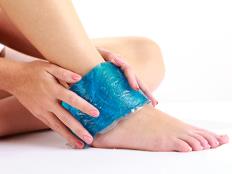4. Plantar Fasciitis
It's not shocking that about 15 percent of all running injuries strike the foot—with each step, our feet absorb a force several times our body weight. Plantar fasciitis, small tears or inflammation of the tendons and ligaments that run from your heel to your toes, is usually the top foot complaint among runners—10 percent of runnersworld.com poll respondents struggled with it this past year. The pain, which typically feels like a dull ache or bruise along your arch or on the bottom of your heel, is usually worse first thing in the morning.
WHO'S AT RISK?
Runners with very high or very low arches are vulnerable, Saxena says, because both foot types cause the plantar fascia to be stretched away from the heel bone. Other causes are extreme pronation (foot rolls inward excessively) or supination (foot rolls outward excessively) and increasing your mileage too quickly. Long periods of standing, especially on hard floors without supportive footwear, may exacerbate the problem. Tight hip flexors, weak core muscles, and a history of lower back pain can also contribute.
"Back issues and core weakness can lead to subtle changes in your stride that you'll feel in the feet," Merrill says.
CAN YOU RUN THROUGH IT?
Plantar fasciitis is one of the most notoriously nagging injuries, and running through it, while possible, can delay healing. Recovery time can range from three months to a year, but six months is fairly typical, Saxena says. In chronic cases, a complete break from running is usually best. Pool running and swimming keep pressure off your feet. Cycling or using an elliptical can help you maintain fitness, but only if you can do those activities without pain. Wearing a Strassburg sock while you relax keeps your arch from tightening up.
REHAB IT
Roll your foot over a frozen water bottle for five minutes at a time, five times a day, Saxena says. To stretch your plantar fascia, sit with one leg crossed over the other so that your right ankle rests on your left knee. Grab the end of your right foot at the toes and gently pull back. Because calf tightness can be a factor, Merrill also recommends using a foam roller to loosen them up. He also stresses the importance of doing core work (planks, back extensions).
"When I see someone who has had plantar pain for years, they're almost always missing core strength," Merrill says. "Sometimes all they need is some core work and their heel gets better. A stable core reduces stress on the spine and stops pain transference to the foot."
PREVENT A RELAPSE
Make sure your shoes fit your foot type by getting an analysis at a running shoe store or from a podiatrist or physical therapist, says Saxena. A custom orthotic may even help. Stretch and massage the plantar fascia several times a day. In the morning, hang your feet over the edge of the bed and roll your ankles. Do core work at least twice a week.
ELITE TREATMENT
Magdalena Lewy Boulet, a 2:26 marathoner, struggled with plantar fasciitis in 2007 that became so severe she contemplated ending her career.
"I got on a rehab routine that included active-isolated stretching, and it cured me," she says. "Now it's part of my maintenance routine. I do it for about 15 minutes twice a day."
Foot Wary: How to Proceed
Ongoing, ever-present arch pain and tenderness that doesn't seem to fade even once you've warmed up on a run.
If you experience any pain when you step out of bed, get up after sitting for a long time, or during the first few minutes of a run.
When you are pain-free all day, including your first steps in the morning. Walking barefoot on hard surfaces isn't an issue.
- 5
- of
- 8
Get ACTIVE on the Go


Couch to 5K®
The best way to get new runners off the couch and across the finish line of their first 5K.
Available for iOS | Android







Discuss This Article